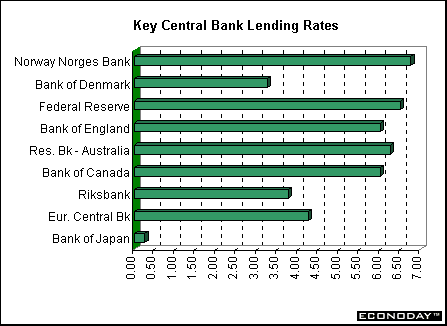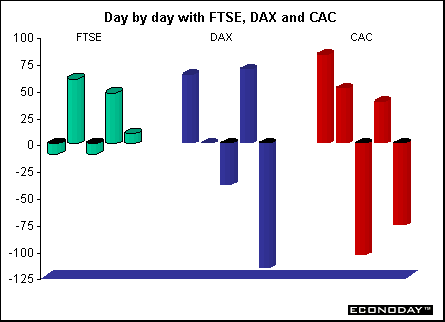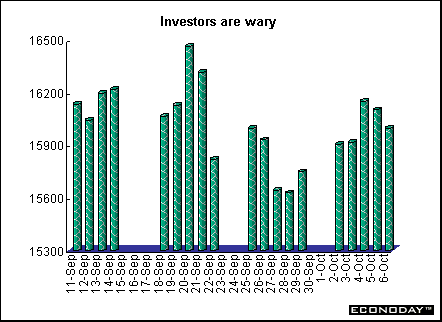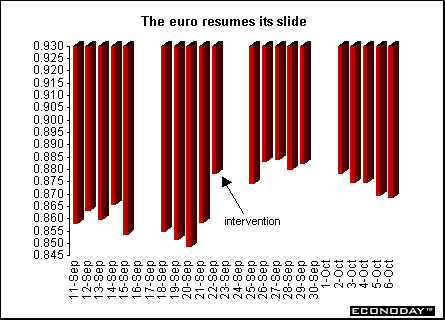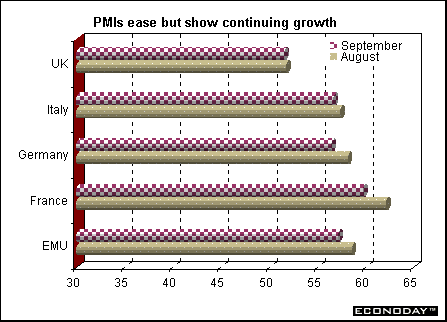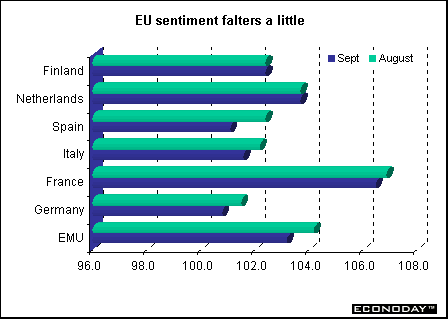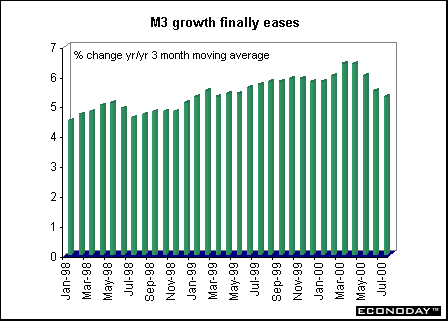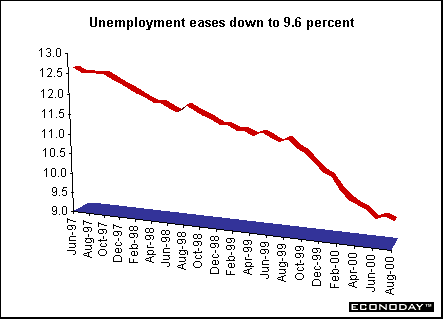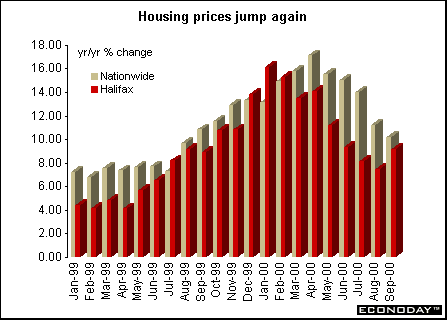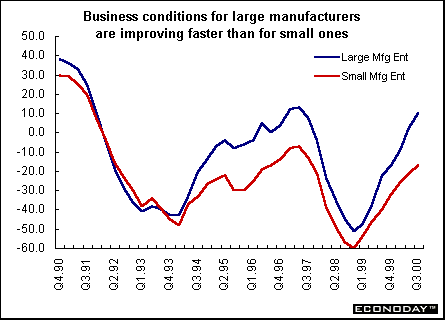| Previous Articles |
|
Central banks and earnings vie for spotlight
The Bank of England did not raise interest rates either, but for different reasons. The meeting's minutes will be released in two weeks (not all that long to wait) to find out why they left rates alone. The two prior meetings produced no rate change by the closest of margins (the votes were 4 to 3). The economy is strong with inflation about 2.1 percent, which is far below its mandated inflation target of 2.5 percent. In addition, average earnings growth has slipped below the bank's 4.5 percent growth rate. The European Central Bank, which is fixated on inflation, surprised the markets and raised its policy making rate by 25 basis points to 4.75 percent. The move narrowed the rate spread to 175 basis points below the United States and 125 basis points below Britain. Contrary to what would be expected, the euro fell on the news to below the intervention level of two weeks ago. The reason given for the rate increase was inflationary concerns triggered by high crude oil prices and the low euro. The harmonized index of consumer prices (HICP) has been above the two percent inflation target for three months. The second pillar of monetary policy - M3 money supply - has consistently been above the ECB's target since its inception. The growth rate now is 5.6 percent compared with the bank's target of 4.5 percent. (See indicator scoreboard below). What bothered the markets was the rate increase's impact on slowing EMU growth. The Central Bank of Denmark followed the ECB and raised its discount rate to 4.75 percent while leaving the 14 day lending rate at 5.6 percent. Denmark, although voting to remain outside the European Monetary Union, maintains monetary policies that are closely aligned to the ECB. Equities begin fourth quarter by fretting over earnings...
Hong Kong markets were closed on Monday and Friday. Britain and Europe
The British markets were little affected by the Bank of England's decision to leave their policy making interest rate alone. The FTSE 100 ended the week on the plus side at 6391.20, up 97 points or 1.54 percent. In Europe, the European Central Bank's increase of 25 basis points took most analysts by surprise. However, the equity markets did not seem to be too upset by the move and were about even on the week. The Frankfurt Dax, after a volatile week, ended at 6776.39, down 21.73 point or 0.32 percent. The Paris CAC was also volatile on the week, closing at 6258.41, down 8.22 points or 0.13 percent. The CAC is the only European index tracked here that is higher (up 5 percent) since the beginning of the year. The FTSE is down 7.78 percent while the DAX is down 2.61 percent. Asia The Nikkei rose on the week as well, but did not manage to break through the 16,000 level. What started off as a positive week thanks to the tankan survey, faded away on Thursday and Friday as fear grew that earnings worries in the United States would cross the Pacific to Japan. The Nikkei closed at 15,994.24, up 246.98 points or 1.57 percent.
Currencies
Indicator scoreboard
The September European Commission's economic sentiment index dropped to 103.2 because of weaker consumer and construction industry confidence and lower equity prices. Consumer confidence dropped sharply, to -3 in September from +1 in August and zero in July. Industry sentiment remained flat but retail sentiment rose slightly.
August M3 money supply rose 5.6 percent and the three month moving average declined to 5.3 percent when compared with last year. Seasonally adjusted private sector credit growth accelerated 0.6 percent.
The July trade surplus with the rest of the world declined to E4.9 billion from the surplus of E12.1 billion a year earlier. Rising import prices because of crude oil are overwhelming a rise in exports due to the weak euro. July exports were up 10 percent from a year ago while imports were up 23 percent. August seasonally adjusted unemployment rate remained at 9.0 percent, unchanged from June and July. This is the lowest unemployment rate in more than eight years. August industrial producer prices (excluding construction) rose 0.2 percent and 5.6 percent when compared with last year. The lower overall rate in August is due to a smaller increase of the intermediate goods index, which includes prices for oil and other commodities affected by the weak euro. Germany - August import prices jumped 1.4 percent on the month and 11.9 percent on the year. Import prices excluding oil products rose 7.6 percent on the year. Crude oil prices were up 7.2 percent on the month. August seasonally adjusted import prices rose 1.4 percent and were 11.9 percent above a year ago. Seasonally adjusted export prices rose 0.3 percent in August from a month earlier and 4.0 percent on the year, after rising 0.3 percent on the month and 3.7 percent on the year in July. September pan-German seasonally adjusted unemployment rate fell to 9.4 percent. The west German unemployment rate declined to 7.5 percent while the east German rate remained the same at 17.4 percent. September joblessness normally declines after the end of the summer months, as teachers and students leave the jobless rolls.
August manufacturing orders jumped 1.7 percent. Foreign demand was up 2.8 percent thanks to the weak euro. Foreign capital goods demand was up 0.5 percent, while foreign intermediate goods orders rose 6.5 percent. However, durable and non-durable consumer goods demand was down 0.3 percent. Domestic orders were up 1.1 percent with the largest increases in the capital goods sector, up 3.0 percent on the month. France - August seasonally adjusted International Labor Organization unemployment rate fell to 9.6 percent. The ILO definition excludes job seekers who did any work during the month. The unemployment rate was 11.3 percent in August 1999.
Second quarter real seasonally and workday adjusted gross domestic product rose 0.7 percent and 3.4 percent when compared with last year. This was unrevised from the first estimate. Italy - July seasonally adjusted unemployment rate was 10.5 percent, down from 10.7 percent in April. Employment surveys are carried out every three months (January, April, July and September). August producer prices rose 0.1 percent and 6.5 percent when compared with last year. A drop in oil prices offset increases in some commodities such as paper and chemicals, mainly due to a strong dollar. Oil product prices fell 0.5 percent on the month. July unadjusted industrial orders were up 1.0 percent when compared with last year. Foreign orders rose 4.0 percent while domestic orders dropped 0.8 percent. July seasonally adjusted orders data sank 6.1 percent. July's adjusted domestic orders fell 0.1 percent on the month, while orders from abroad were down 13.7 percent. Britain - September seasonally adjusted Nationwide building society house price index rose 0.4 percent after falling in the previous two months. The index was up 10.2 percent on the year, down from 11.2 percent in August.
September seasonally adjusted Halifax house prices jumped 1.6 percent and were up 9.2 percent on the year. The annual rate accelerated from 7.4 percent in August but remained well below January's peak of 16.0 percent. The Halifax said the underlying trend - measured by a comparison of the last three months with the preceding three months - shows that the housing market has steadied in the past few months. Second quarter gross domestic product rose 0.9 percent and was revised up to 3.2 percent when compared with last year. The household saving ratio fell to 3.0 percent from 4.4 percent last quarter. Seasonally adjusted housing starts in the three months to August rose 3 percent when compared with the previous three months and rose 2 percent on the year. Total completions in the three months to August fell 4 percent on the quarter and 7 percent on the year. August manufacturing output rose 0.8 percent on the month and 1.1 percent when compared with last year. The increase was mainly due to a 4.1 percent jump in the electrical and optical equipment sector. Within this, output from the 'mobile phones' industry increased a massive 19 percent, following an 11.7 percent monthly fall in July. The August rise was the largest monthly increase on record for this industry. In the three months to August, manufacturing output rose 0.6 percent and was up 1.3 percent on the year. Total August industrial output rose 0.6 percent on the month and 1.6 percent when compared with last year. Asia August seasonally adjusted unemployment rate slipped to 4.6 from the 4.7 percent recorded in July. The labor force participation rate fell to 62.7 from 63.3 the same month a year ago. The Bank of Japan's quarterly tankan survey index showed that confidence among large manufacturers rose to 10 points from 3 in June. That's the highest since June 1997, and means 10 percent more companies are optimistic about conditions than pessimistic.
Americas
August raw material price index (RMPI) rose 2.1 percent after having dropped 2.5 percent in July. If mineral fuels were excluded, the index would have advanced only 4.0 percent instead of 18.9 percent on an annual basis, while the monthly index would have remained unchanged instead of advancing. Crude oil prices were 5.4 percent higher in August compared with July as low inventories raised concerns about meeting winter heating demand. This concern spilled over into the IPPI, as petroleum and coal product prices edged up 0.6 percent. September unemployment rate fell 0.3 percentage points to 6.8 percent. Employment rose 56,000, with the increase being split between full time (up 29,000) and part time (up 27,000) jobs.
BOTTOM LINE Meanwhile, the euro continues to sink. Merger and acquisition activity has created a high demand for dollars and puts downward pressure on the euro as European businesses continue to see business prospects greener on this side of the Atlantic Ocean. Business is waiting for those promised structural demands to improve the working environment. Divergent rhetoric still confuses currency traders as the ECB tries to be more transparent.
Release dates are subject
to change. |
|||||||||||||||||||||||||||||||||||||||||||||||||||||||||||||||||||||||||||||||||||||||||||||||||||||||||||||||||||||||||||||||||||||||||||||||||||||||||||||||||||||||||||||||||||||
